

|
Back to |
| The Front Page |
| Letters & Opinion |
|
Trials and triumph in San Miguel de Allende by Mary Kloubec photos by Dixon Adams |
What possibly can I wear to this?
Finding water in the desert is easier than forging peace between warring factions of mallet wielders on Mexico's croquet frontier. Both these miracles have lately occurred in San Miguel Allende, a Spanish colonial town and official national monument that sits more than a mile high upon Mexico's central plateau in a climate of eternal spring. The population of 50,000 or so souls includes perhaps 3,000 more in the winter, many of them U.S. citizens, half a hundred of whom have created a special bond through the play of our favorite sport. The world's largest city, barely 180 miles southeast, has no croquet. These ex-pats play in the only USCA-affliated club in the country. And thereon hangs the tale told by our correspondent...
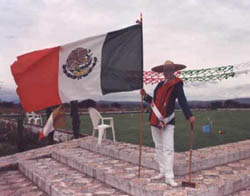
|
| Dr. Bett Yates Adams, San Miguel resident player, USCA member-at-large, and first female publisher (retired) in the New York Times chain, hoists the flag in full regalia to dramatize the opening of Mexico's newest court. |
It was a group of unweak souls who gathered in a flower-filled patio on April 3, 1993, to dissolve the once mighty San Miguel de Allende Croquet Club.
Picking and choosing judiciously among my nearly all white casual wear that day, I hit upon...white!, with a black arm band - a wearable voice of mourning, regret and protest against what was surely soon to pass. Nobody got it. Too subtle.
The whys and wherefores leading up to that unfortunate watershed moment in local croquet history are shrouded now in the gauze of individual selective memories. And downright yarn, as peevish gossip morphed into legend.
The Halcyon days
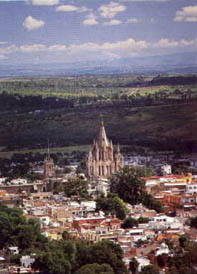
|
| San Miguel de Allende |
Spotless croquet days without end, amen.
The wretched Grinch
Later on, those golden days grayed. Cheerless words of committee appointments, private meetings, the next election and Robert's Rules of Order gathered ominously on the horizon, then squatted overhead, sheeting down dun-colored rain and shooting witch fingers of lightning at the frightened, unsuspecting croquet children jailed together in the small clubhouse with Alice in Wonderland stained glass windows.
The Mexican fairytale croquet story was history, eaten in it's youth by raging, full-blown political intrique which had taken on a bizarre life of it's own. The hideous monster died not by a stake through the heart but by the bang of a gavel in that flower-filled patio more than six years ago.
The Mothers of Mad
Nobody won. No one was happy. Everyone was shell-shocked, reeling and stunned. And plenty of people were still plenty mad, the Mothers of Mad nursing their ugly grudges.
The good news? No slug fest.
That mess was years ago now, but the surreal mental snapshots are frozen crisp. Just thinking back on it is an exercise in retro scab-picking. It makes me fearful and edgy. By giving it thought, will the monster regain psychic energy? Rise again?
But that is childish, there is no man under the bed and we're all grownups now, aren't we?
Staggering in the aftermath, a small group tentatively approached Marie Trott, a Canadian longtime resident of San Miguel and owner of the San Miguel de Allende Croquet Club (SMACC) venue. In frustration and anger, she'd slammed shut the court gates in the heat of the discontent. (It was rumored that what really ticked her off was the disgruntled member in charge of wicket painting who, before stomping off, artlessly handed her his brushes and paint pots in the middle of a game.)
"If everyone minds their manners, could a few come back and play croquet? Please, Marie? Pretty please? We're all grownups now. We promise to behave."
The gates creaked back open.
Gee, that hurt
And so, burned and smarting still from the blowup, wary of the problems caused by industrial strength, top-heavy micromanagement in a small croquet club (in the middle of Mexico, for god's sake), a scaled-down, hang-loose SMACC mewed back to life on Marie Trott's property.
It was followed two long, hard, trying years later, by THE Croquet Club, whose robust, croquet-starved members were led by ex-Beverly Hills player Jack Sisto, the acknowledged sire of recent Mexican croquet...although Sisto insists he just blew life into a legacy left by New Yorker Chet Herzog, who is honored in an annual SMACC tournament.
Sisto hurdled high, formidable wickets in thin mountain air to get a second croquet court started here. Out of breath but victorious, Sisto and his members decreed the THE of THE Club's name stand tall and stalwart in capital letters, defining itself proudly and separately from arch rival SMACC, a rivalry which is calming down at last.
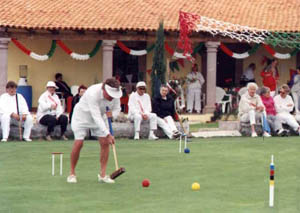
|
| Dr. Frank Stuart, owner and croquet impressario of Rancho Pancho, won the Championship Flight of the first tournament on the new court. |
THE club's damn good greensward is leased from Dr. Hope Harmon (PhD medical engineering), a Mexican-born U.S. citizen and resident of Arlington, Virginia, and San Miguel de Allende, and land holder of consequence in San Miguel. She's a USCA member, won the US Open International Rules "A" flight in 1996 and 97 in Palm Springs and is one of only two remaining Mexican players - the all time high was six - in this town which has about 55 ex-pat players.
"There aren't more Mexican players because they just don't know about it. Even the well-educated Mexicans have never heard the word croquet, have never been exposed to the game," says Harmon, who was first introduced to garden croquet at homes she visited when resident in Washington, D.C. and a member of that city's English Speaking Union.
Croquet? Qué es?
People in this country would rather golf. Period. Just ask any Mexican dentist or doctor. And those clubs would be the natural place for croquet exposure to begin, but it becomes circular. There's no demand for croquet because nobody knows what it is. Nobody knows what it is, because they've never seen it, hence, there's no demand. The lone exception? A Monterrey gentleman who saw the game played in California and was so taken with it he built a family court at his home in that northern industrial city.
Says THE Club's Jack Sisto, "At one point we tried to involve more Mexicans, but with no great success. Two couples paid their dues, bought mallets, took lessons, but it's a complicated game, and they were lukewarm. And the country club here offers more family and social stuff." Score another one for the rampant, insidious country club think ethic.
Not entirely guilty
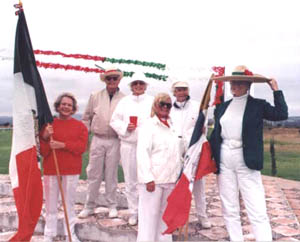
|
| (Left to right) Virginia Harrison (with flag), Dick Lusby, Jean Winterhalder, Allison Gubelman, Mary Kloubec, Bett Adams. |
Yes, we've gotten bogged down with infighting and stupidity, and the grander ideals of croquet as a metaphor for life have, at times, whizzed past San Miguel. But we're learning lessons. We're trying to be grownups now.
And yes, we are a gang of gringos down here playing at a game which has changed many lives for the better. It may appear we're living off the fat of the land, but mostly we are curious, well-traveled folk just trying to get the biggest bang for our hard-earned retirement buck. We've voted with our feet against gated-communities, strip malls and sanitized life overlooking the fourth fairway. Occasionally we step in donkey dirt, but we awaken to the sound of church bells. We welcome visitors from the North, but if you can't appreciate what you see, quietly and politely press on.
|
Finding water in the desert by Mary Kloubec |
Dr. Frank Stuart's twenty-two acres lie upon a rural, sparely populated campo six miles outside the town on a good state highway - beyond the reach of urban land and water prices. The splendid isolation comes at a price and carries a certain risk if you intend to build and maintain a 10,000 square foot croquet lawn on a high desert. Our correspondent recalls the risk and the reward.
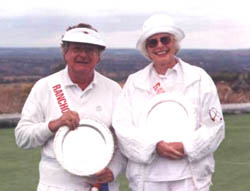
|
| (Left to Right) Dr. Frank Stuart, owner and croquet impressario of Rancho Pancho, won the Championship Flight of the first tournament on the new court. With him, Jean Winterhalder, winner of "A" flight. |
Frank Stuart grabbed a red plastic cup, filled it with water from the hose and said, "Here."
The lady studied the contents of the cup as if it were toxic waste, sniffed at it, shock and fear registering in her eyes. In this country of "Don't Drink the Water," she'd just been offered a sip from the hose. Dismayed and silently beseeching, she looked to her husband for a hint.
He took the cup, drained it, refilled it from the hose and said, "Here. Drink this."
She drank.
She said, "Why is the water so hot? Will I die tonight?"
She lived.
She made it to the party that night and to all her planned Mexican holiday events. A year and a half later, she's in dandy health, with no reports of intestinal misfortune.
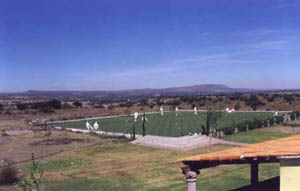
|
The dismayed Connecticut lady was standing in the midst of Rancho Pancho in its earliest, war-zone phase, a croquet court horsed into existence by Dr. Frank Stuart, a retired orthopedic surgeon from Florida - "Pancho" being the Spanish diminutive of Frank, Francisco - and the third croquet court built in San Miguel and environs in the last ten years.
How difficult was it to build a proper croquet court here, in Mexico?
"Most anterior cervical fusions take 45 minutes'," says Dr. Stuart. "This thing took more than two years. You figure."
Why does San Miguel need so many croquet courts?
"Well, we don't really NEED all these courts, it just sort of happened that way. And, well, people will be people," says Stuart incisively of an unhappy divide between a once singular croquet club.
"I just wanted my own croquet court, to see if I could do it here, in the Mexican desert. I love croquet and seem to love the agony of grass."
There are lots of wild grasses around here...river bottom grass in the valleys, quack grass, duck grass, the pink grass. Why don't you have any bad grass in your court yet?
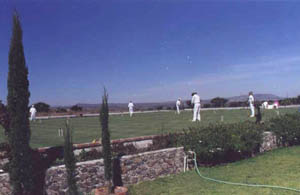
|
So in the middle of nowhere Mexico, how did you know where to dig for water?
"Standing here," he points to the dry, rocky soil, "you're on top of a big aquifer. But we had no clue where to dig. To a man, the workers standing around said, 'Find a brujo del aqua.' " In English that's a water witch, a diviner, a guy with a fork-shaped wand who walks around until the stick - usually made of watery willow seeking its feet - dips.
"The next day, a guy shows up with his wand and it dips by the big cactus. Do I believe this? We needed a second opinion.
"The second brujo del aqua goes to the same big cactus. His stick dips. Okay. Let's go for opinion number three."
Numero Tres goes right to the big cactus and his water wand not only dips, it breaks in half. Truly. We called in the digging rig.
But the rig doesn't dig. It pounds. It bashes. The rig attendants set up camp and fashion their fire pit under a nearby mesquite tree, the low branches perfect for laundry. For two days, the rig slams through eons of limestone.
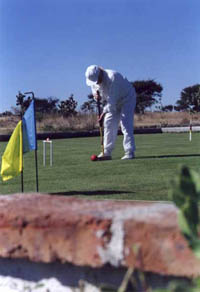
|
The Neighbor's family has overseen this ridge for centuries, and his high dudgeon kicks in at the threat of Gringo interlopers. Are they building a golf course? He's sure they are. His hot water bathing spa may be at risk. It's a duel between the two macho men to the second blow of the sticks, then cooler heads prevail.
The Neighbor calls the Water Police, re: proper permits.
"I trusted the guy who told me everything was in order," says Stuart of the permits.
On Day Three, the digging stops. The rig attendants break camp and head off.
Day Thirty. A proper permit arrives and the rig attendants reestablish camp. A month later, they hit some water at 50 meters.
Day Ninety. At 100 meters, the rig crashes through the roof of an underground cavern to water which comes and goes at 15 minute intervals.
Day One-Twenty. At 150 meters, a steady, warm crystal-clear flow of water gushes through the pipe at 75 gallons per minute. The smiling rig attendants decamp with bonuses in hand and Rancho Pancho is finally a go.
THE AUTHOR: Mary Kloubec, a retired journalist and USCA member, started playing croquet in the Bahamas and is active in all three croquet clubs in San Miguel. Contact her at drcutup@unisono.net.mx. Guests are welcome with notice at the Rancho Pancho court.
THE PHOTOGRAPHER: Dixon Adams is a Mexican-based freelance photographer residing in San Miguel and a USCA member-at-large. Contact him at bettdixn@unisono.net.mx.